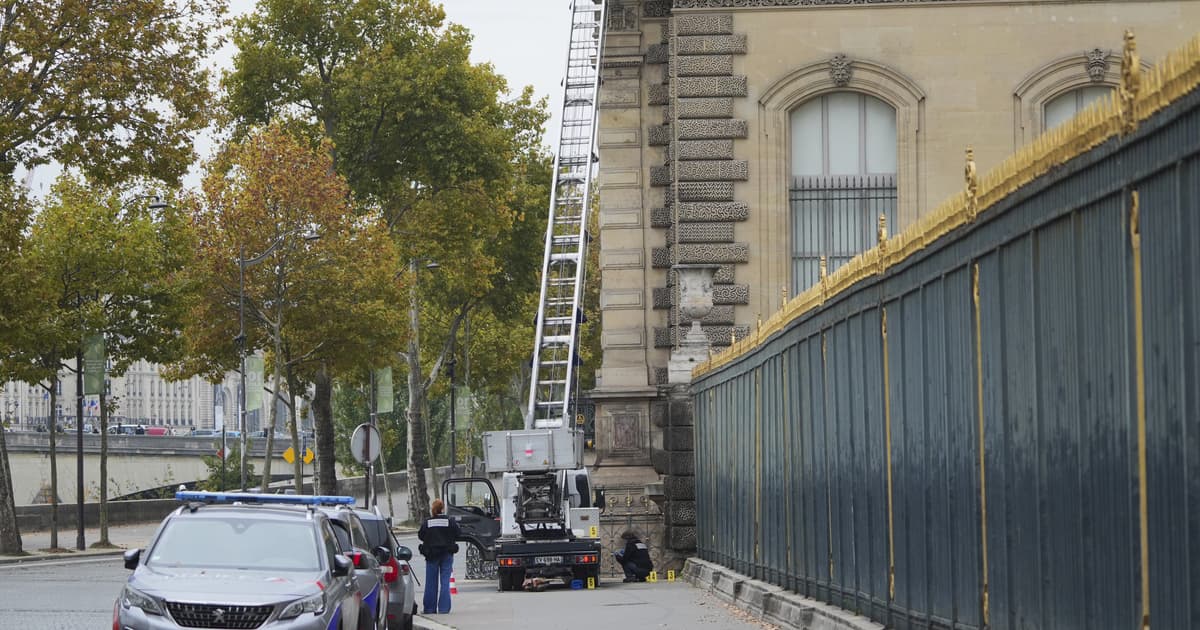The case has not left French public life in peace since then. Not least because the robbers had a ridiculously easy time getting to the upstairs gallery and, with the coolness and professionalism typical of crime novels, they took almost the most valuable pieces of the collection: a necklace, a brooch and a tiara.
The side of the museum where you entered is currently being renovated.
The French police have assigned a special unit to the case, but experts say that as the days pass, the likelihood of finding the art treasures decreases.
Meanwhile, it was revealed that the perpetrators used a crane to descend onto the Seine bank, then left the scene on scooters and with eight crown jewels. The first footage of how the perpetrators escaped after robbing the Apollo Gallery of the Louvre museum in seven minutes has been released.
🇫🇷 First footage of the Louvre heist shows burglars fleeing wildly
— Visegrád 24 (@visegrad24) October 23, 2025
Initially on a forklift, then on scooters through Paris streets.
Crown jewels worth €88 million were stolen from the Louvre's Apollo Gallery on Sunday. The heist lasted only 7 minutes and involved 4 suspects. pic.twitter.com/FXS2sl0jLE
A Dutch art detective, Arthur Brand, said he believed the jewels had already been dismantled into hundreds of pieces and disappeared, or had been smuggled out of France. Others believe that if the gems were cut into small pieces, they could have been sold for a fraction of their original value.
Who could the jewel thieves have been?
According to the art detective, they are clearly professionals, as evidenced by how quickly they got in and disappeared with the loot. This was probably not their first robbery, they may have done similar things before. The fact that the French police take robbers very seriously is also evidenced by the fact that the case was assigned to a group that has “already achieved serious success in solving large-scale robberies”. The authorities suspect that they are dealing with an organized crime network specializing in art thefts. If this is the case, it is not inconceivable that some of them have already had dealings with the police. All this could be facilitated by DNA testing of tools found at the scene and samples taken from a vest.
According to Paris prosecutor Laure Beccuau, such organized crime groups usually have two goals. One is to acquire the artworks for the benefit of those organizing and financing the operation, or to use the acquired gems to carry out large-scale money laundering operations. However, these are such well-known pieces that it is impossible to simply sell them on the black market. Whoever ends up with the pieces at all will not know what to do with them, as they cannot show them to their friends, their children cannot inherit them and selling them is probably out of the question.
How much could the stolen jewelry be worth?
The Dutch detective thinks that the individual pieces will be taken apart, the gold and silver melted down, and the precious stones broken into smaller pieces, making it virtually impossible to trace them back to the Louvre robbery.
Jewelry historian Carol Woolton, who was the jewelry editor of Vogue magazine for 20 years, told the BBC that the robbers had professionally selected the most valuable gems from the Louvre's collection.
The beautiful, large, flawless stones will probably be removed from their settings and sold, except for the crown of Empress Eugenie, which has smaller stones set in it and is too risky to appear on the black market without getting caught
– he added. This could easily explain why the crown was thrown away along with another object while fleeing and was found by the authorities.

Carol Woolton fears that the robbers will turn to an organ dealer who, despite the hype, is still willing to deal with the stolen goods, and therefore the priceless jewels are likely to change hands for small change.
When asked how much the loot could be worth, experts say:
approximately 10 million pounds, or approximately 4.5 billion forints.
The split gems alone could be worth millions of pounds. Tobias Kormind, managing director of online jewellery store 77 Diamonds, estimated the value of all the jewels together at around £10 million.
The thieves would need a skilled jeweller to remove the gems and a professional diamond cutter to transform the larger, more recognisable stones. Smaller stones that are not easily identifiable can be sold immediately and while it would be difficult to say the exact value of all the gems stolen, the larger ones could be worth around £500,000 each, he said.
There are at least four of them of this size, so if you add them up, plus the gold and silver, you're probably approaching £10 million
– Tobias Kormind summed up.
As the days pass, the hope that the entire stolen jewels will be recovered in one piece is diminishing. However, there is a counterexample to this. The V&A Museum's Cartier exhibition features a jewel stolen in 1948 that resurfaced at auction decades later.

